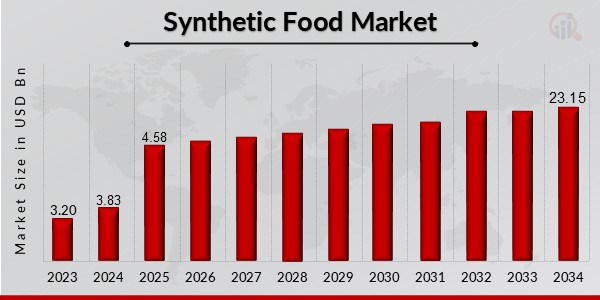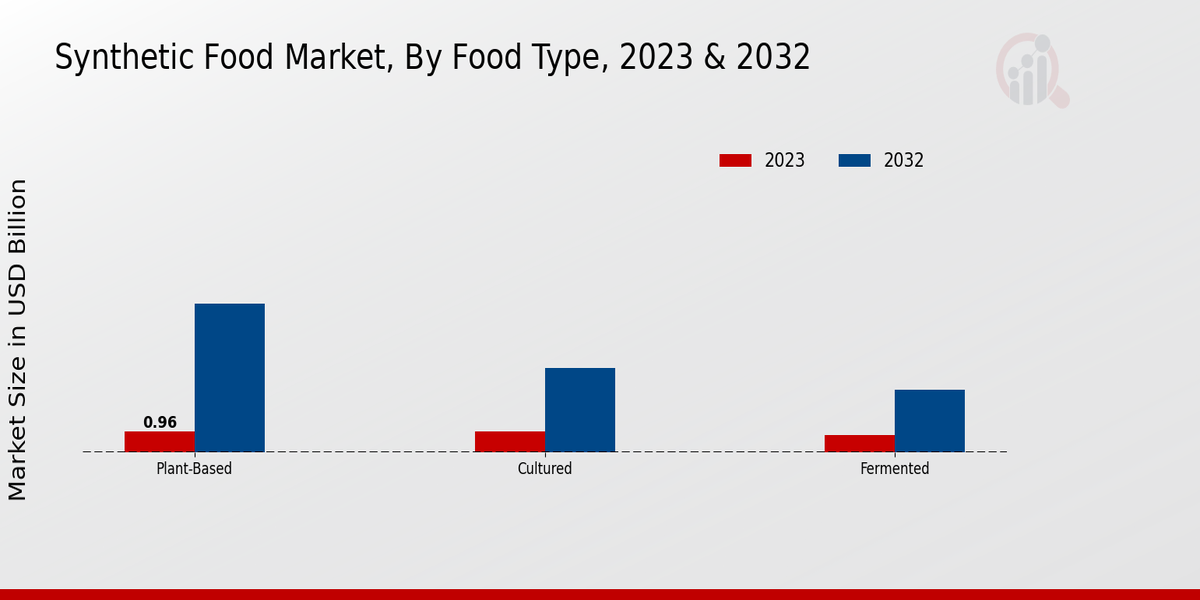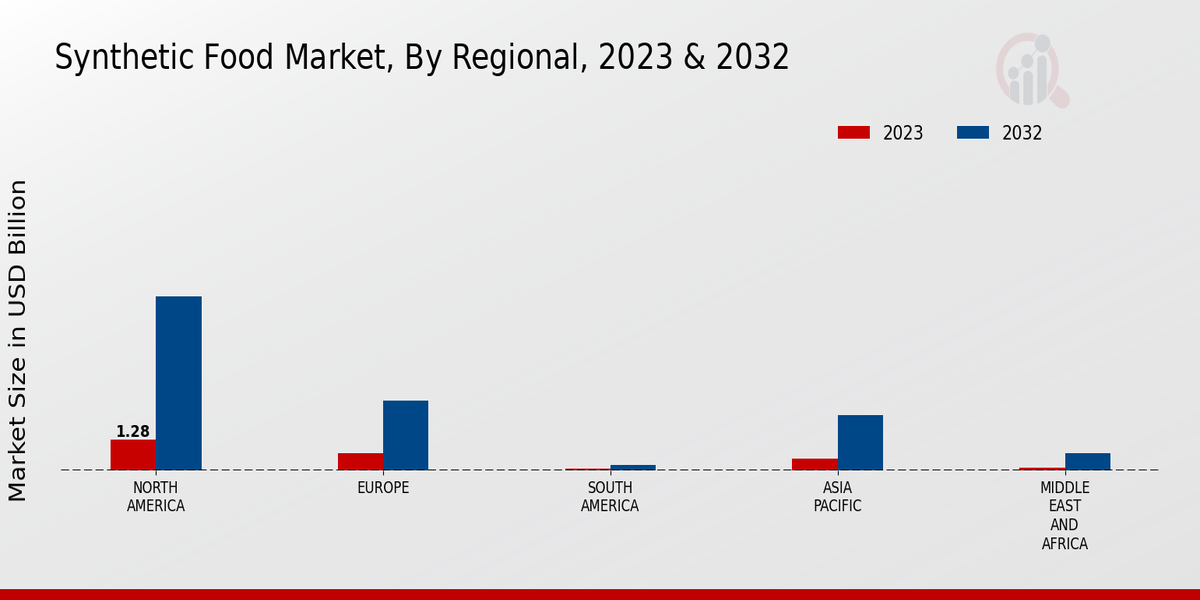Global Synthetic Food Market Overview
Synthetic Food Market Size was estimated at 3.83 (USD Billion) in 2024. The Synthetic Food Industry is expected to grow from 4.58 (USD Billion) in 2025 to 23.15 (USD Billion) by 2034. The Synthetic Food Market CAGR (growth rate) is expected to be around 19.7% during the forecast period (2025 - 2034).

Source Primary Research, Secondary Research, MRFR Database and Analyst Review
Key Synthetic Food Market Trends Highlighted
The synthetic food market has great potential and the major driving forces are the increasing demand for healthier and better substitutive options. The rising issues regarding climate change, animal ethics, as well as food concerns have positively contributed to the rapid uptake of synthetic meats, fish and milk products. Also, a further enhancement of food technologies and low cost production processes will also boost the growth of the market.
There are opportunities within the synthetic food market such as the introduction of new products and also product formulations that are designed to address the needs of all the consumers. There is also huge reproductive potential in the prospects of extending the use of synthetic foods into space and emergency operations. In addition, open innovation between food companies, technology companies and research can accelerate growth and speed up the market.
The recent changes in synthetic food marketing include the advent of plant-based alternatives, which aim to replace meat products that match the taste, aroma and nutritive characteristics. An increasing trend is the acceptance of cellular cultivated meat grown from animal cells. Also, the deployment of the AI aspect is changing the dynamics of producing and developing synthetic food.
Synthetic Food Market Drivers
Rising Demand for Sustainable and Ethical Food Sources
The increasing recognition of the undesirable consequences for our environment, which traditional food production methods entail, has caused a growing need for sustainable and ethical alternatives. The solution to this challenge is the development and adoption of synthetic food, which can be produced on a significantly smaller amount of land, using less water, and requiring less energy than traditional farming. Moreover, synthetic food can be engineered to fit the precise dietary needs of individuals, which may facilitate their adoption of healthier diets by avoiding different types of processed or unhealthy food and reducing the amount of waste which goes uneaten.Consequently, the Synthetic Food Market Industry is expected to benefit from the growing demand for sustainable and ethical sources of food.
Technological Advancements and Innovation
Rapid advancements in biotechnology and food science are enabling the development of new and innovative synthetic food products. These advancements include advances in cell culture techniques, fermentation processes, and flavor and texture engineering. As technology continues to evolve, the range and quality of synthetic food products will continue to improve, further driving market growth.
Government Support and Regulatory Framework
With increasing emphasis on accepting synthetic food as an efficient way of mitigating the food crunch and making progress toward sustainability, governments are becoming more supportive and investing more in research and development efforts related to synthetic food. In addition to this, the establishment of adequate regulation to ensure the safety and quality of these food products is becoming another trend. Hence, being confident about the safety and quality of the synthetic food products and offering adequate assurance will open up gateways for enhanced investment and economic growth for the Synthetic Food Market Industry.
Synthetic Food Market Segment Insights
Synthetic Food Market Food Type Insights
The Synthetic Food Market segmentation by Food Type into Plant-based, Cultured, and Fermented offers valuable insights into the industry's landscape. In 2023, the Plant-based segment held a dominant share of the market, valued at USD 1.23 billion, primarily driven by the increasing demand for vegan and vegetarian alternatives to traditional animal products. The Cultured segment is expected to witness significant growth in the coming years, owing to advancements in cellular agriculture and the rising popularity of lab-grown meat products. Moreover, the Fermented segment is poised to make a notable contribution to the market, driven by the growing awareness of the health benefits associated with fermented foods.The Plant-based segment is projected to maintain its leading position throughout the forecast period, reaching a projected valuation of USD 6.78 billion by 2032, exhibiting a CAGR of 19.2%. The increasing adoption of plant-based diets due to ethical, environmental, and health concerns is fueling the growth of this segment. Cultured meat, also known as lab-grown meat, is gaining traction as a sustainable and ethical alternative to conventionally produced meat. The Cultured segment is anticipated to grow at a robust CAGR of 22.5%, reaching a projected value of USD 3.87 billion by 2032.Fermented foods have been gaining popularity due to their health-promoting properties. The Fermented segment is expected to grow at a steady CAGR of 17.6%, reaching a projected valuation of USD 2.85 billion by 2032. The growing consumer demand for functional and probiotic-rich foods is driving the growth of this segment. Key market players in the Synthetic Food industry are focusing on developing innovative products and expanding their production capacities to meet the growing demand for plant-based, cultured, and fermented food products.

Source Primary Research, Secondary Research, MRFR Database and Analyst Review
Synthetic Food Market Application Insights
The application segment of the Synthetic Food Market is primarily driven by the rising demand for plant-based alternatives to animal products. Dairy alternatives, meat substitutes, fish alternatives, and egg alternatives are gaining popularity due to increasing awareness of animal welfare, environmental concerns, and the prevalence of lactose intolerance and other dietary restrictions. In 2023, the dairy alternatives segment held the largest market share, valued at USD 1.2 billion, and is projected to continue dominating the market throughout the forecast period.The meat substitutes segment is expected to grow at the highest CAGR of 22.5% during the same period, driven by the increasing consumption of plant-based meat products. Fish alternatives and egg alternatives are also witnessing steady growth, owing to the growing vegan and flexitarian population.
Synthetic Food Market Production Method Insights
The Synthetic Food Market segmentation by Production Method comprises Cell-based, Plant-based Protein Extraction, and Microbial Fermentation. Cell-based synthetic food, produced by cultivating animal cells, offers a sustainable and ethical alternative to traditional meat production. In 2023, the cell-based segment held a significant market share due to increasing investments in research and development. Plant-based protein extraction involves isolating proteins from plant sources like soy, pea, and wheat to create meat alternatives. This method is gaining popularity due to rising consumer demand for plant-based diets.Microbial fermentation utilizes microorganisms to produce synthetic food ingredients like proteins, fats, and flavors. It is expected to witness significant growth owing to advancements in biotechnology and cost-effective production processes. The Synthetic Food Market segmentation by Production Method provides valuable insights into the diverse approaches used to create synthetic food products, enabling stakeholders to make informed decisions and capitalize on growth opportunities.
Synthetic Food Market Ingredient Source Insights
Soy holds the dominant position in the ingredient source segment, capturing over 45% of the Synthetic Food Market revenue in 2023. Its versatility, cost-effectiveness, and high protein content make it a preferred choice for various synthetic food applications. Pea and almond follow closely with significant market shares, driven by growing consumer demand for plant-based proteins. Rice, though a smaller segment, is gaining traction due to its hypoallergenic and gluten-free properties, catering to specific dietary needs. The Synthetic Food Market segmentation based on ingredient source provides insights into the diverse raw materials used in synthetic food production, helping manufacturers identify growth opportunities and optimize their product offerings.This data is crucial for understanding market dynamics, developing targeted strategies, and capitalizing on emerging trends within the Synthetic Food Market industry.
Synthetic Food Market Distribution Channel Insights
The distribution channel segment plays a crucial role in driving the growth of the Synthetic Food Market. Supermarkets/Hypermarkets hold a significant market share due to their wide reach and established customer base. These channels offer a diverse range of synthetic food products, catering to the growing consumer demand for convenience and healthy options. Online Retailers have emerged as a rapidly growing channel, capitalizing on the increasing consumer preference for online shopping. They provide a convenient platform for consumers to access a wider selection of synthetic food products, including niche and specialized items.Health Food Stores cater to the specific needs of health-conscious consumers, offering a curated selection of synthetic food products that meet dietary restrictions and preferences. Foodservice channels, including restaurants and catering services, are expected to witness steady growth as synthetic food products gain acceptance in the food industry.
Synthetic Food Market Regional Insights
The Synthetic Food Market is segmented into North America, Europe, APAC, South America, and MEA. North America is expected to hold the largest market share in 2023, owing to the presence of major players and high adoption of synthetic food products. Europe is expected to witness significant growth during the forecast period, driven by increasing consumer awareness and government initiatives. APAC is projected to be the fastest-growing region, with China and India emerging as key markets. South America and MEA are expected to contribute a smaller share to the overall market but are expected to show steady growth in the coming years.

Source Primary Research, Secondary Research, MRFR Database and Analyst Review
Synthetic Food Market Key Players And Competitive Insights
Major players in the Synthetic Food Market industry are constantly striving to gain a competitive edge by investing in research and development, forming strategic partnerships, and expanding their product portfolios. Leading Synthetic Food Market players are focusing on developing innovative technologies to enhance the taste, texture, and nutritional value of their products. They are also exploring new applications for synthetic food, such as in the production of meat alternatives and personalized nutrition. The Synthetic Food Market development is expected to be driven by rising consumer demand for sustainable and healthy food options, as well as technological advancements. The Synthetic Food Market Competitive Landscape is characterized by the presence of both established and emerging players.Perfect Day is a leading company in the Synthetic Food Market. The company specializes in developing and producing animal-free dairy products. Perfect Day's mission is to create a sustainable, cruelty-free, and delicious dairy alternative that is indistinguishable from traditional dairy products. The company's products are made using a proprietary fermentation process that produces identical proteins to those found in cow's milk. Perfect Day's products are available in a variety of formats, including milk, cheese, and ice cream. The company has partnered with several major food companies to bring its products to market.Beyond Meat is a leading competitor in the Synthetic Food Market. The company specializes in developing and producing plant-based meat alternatives. Beyond Meat's mission is to create delicious, nutritious, and sustainable meat alternatives that are indistinguishable from traditional meat products. The company's products are made using a variety of plant-based ingredients, including peas, soy, and rice. Beyond Meat's products are available in a variety of formats, including burgers, sausages, and meatballs. The company has partnered with several major fast-food chains to bring its products to market.
Key Companies in the Synthetic Food Market Include
- Atlast Food Co.
- Plantcraft
- Motif FoodWorks
- Beyond Meat
- Redefine Meat
- Aleph Farms
- Nature's Fynd
- MeaTech 3D
- Heura
- Hoxton Farms
- Novameat
- SavorEat
- Impossible Foods
- V2Food
- ENOUGH
Synthetic Food Market Industry Developments
The synthetic food market is projected to reach USD 13.5 billion by 2032, exhibiting a CAGR of 19.72% during the forecast period (2024-2032). Rising concerns about food safety, increasing demand for sustainable food sources, and growing investments in research and development are key factors driving market growth. Recent developments include the launch of precision fermentation-based synthetic meat products by companies like UPSIDE Foods and Vow Foods. Moreover, governments worldwide are implementing supportive regulations to promote the adoption of synthetic food technologies. However, challenges such as consumer acceptance, regulatory hurdles, and the high cost of production may hinder market growth.
Synthetic Food Market Segmentation Insights
- Synthetic Food Market Food Type Outlook
- Plant-based
- Cultured
- Fermented
- Synthetic Food Market Application Outlook
- Dairy Alternatives
- Meat Substitutes
- Fish Alternatives
- Egg Alternatives
- Synthetic Food Market Production Method Outlook
- Cell-based
- Plant-based Protein Extraction
- Microbial Fermentation
- Synthetic Food Market Ingredient Source Outlook
- Synthetic Food Market Distribution Channel Outlook
- Supermarkets/Hypermarkets
- Online Retailers
- Health Food Stores
- Foodservice
- Synthetic Food Market Regional Outlook
- North America
- Europe
- South America
- Asia Pacific
- Middle East and Africa
| Report Attribute/Metric |
Details |
| Market Size 2024 |
3.83 (USD Billion) |
| Market Size 2025 |
4.58 (USD Billion) |
| Market Size 2034 |
23.15 (USD Billion) |
| Compound Annual Growth Rate (CAGR) |
19.7% (2025 - 2034) |
| Report Coverage |
Revenue Forecast, Competitive Landscape, Growth Factors, and Trends |
| Base Year |
2024 |
| Market Forecast Period |
2025 - 2034 |
| Historical Data |
2019 - 2023 |
| Market Forecast Units |
USD Billion |
| Key Companies Profiled |
Atlast Food Co., Plantcraft, Motif FoodWorks, Beyond Meat, Redefine Meat, Aleph Farms, Nature's Fynd, MeaTech 3D, Heura, Hoxton Farms, Novameat, SavorEat, Impossible Foods, V2Food, ENOUGH |
| Segments Covered |
Food Type, Application, Production Method, Ingredient Source, Distribution Channel, Regional |
| Key Market Opportunities |
Growing vegan population Personalized nutrition Labgrown meat alternatives Functional food ingredients ecommerce expansion |
| Key Market Dynamics |
Growing consumer awareness Technological advancements Increase in RampD investments |
| Countries Covered |
North America, Europe, APAC, South America, MEA |
Frequently Asked Questions (FAQ) :
The synthetic food market size was valued at USD 3.83 billion in 2024 and is projected to reach USD 23.15 billion by 2034, exhibiting a CAGR of 19.7% during the forecast period.
North America is expected to dominate the synthetic food market over the forecast period. The region's dominance can be attributed to the growing adoption of plant-based diets, the increasing demand for sustainable food sources, and the presence of key players in the region.
Synthetic food has a wide range of applications, including meat alternatives, dairy alternatives, and egg alternatives. Plant-based meat alternatives are expected to account for the largest share of the market due to the growing popularity of vegan and vegetarian diets.
The key competitors in the synthetic food market include Impossible Foods, Beyond Meat, and Eat Just. These companies are investing heavily in research and development to improve the taste and texture of their products and expand their product offerings.
The key trends driving the growth of the synthetic food market include the rising demand for plant-based foods, the increasing concerns about animal welfare, and the growing awareness of the environmental impact of traditional food production.
The synthetic food market faces several challenges, including the high cost of production, the regulatory hurdles, and the consumer acceptance of synthetic food products.
The synthetic food market is expected to grow at a CAGR of 19.7% from 2025 to 2034.
The major factors contributing to the growth of the synthetic food market include the rising demand for plant-based foods, the increasing concerns about animal welfare, and the growing awareness of the environmental impact of traditional food production.
The key strategies adopted by players in the synthetic food market include product innovation, strategic partnerships, and geographical expansion.
The future outlook of the synthetic food market is positive. The market is expected to continue to grow at a robust pace due to the increasing demand for plant-based foods, the growing concerns about animal welfare, and the growing awareness of the environmental impact of traditional food production.

















